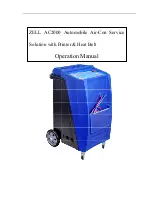
RespiraSense
™
Instructions For Use
RespiraSense
™
PDS-801-007 Revision 2
Page
3
of
77
Indications for Use
●
The RS Device is intended to act as a short-term continuous monitoring device. It assesses
respiratory performance over time by continuously recording, storing, and periodically
transmitting respiratory rate data.
●
The RS Device does not perform a diagnostic function, the data that it collects simply displays
the patient’s respiratory rate. Clinicians use this data to help make or rule out possible
diagnoses.
●
The RS Device can emit an audible alert if the measured respiratory rate exceeds pre-
determined thresholds.
●
The respiratory rate information that the RS Device obtains must be evaluated by clinicians on
a case-by-case basis.
●
The RS Device may record abnormal data. Any abnormal data must be evaluated by a clinician.
Clinicians should assess additional physiological parameters or run additional tests before
making a diagnosis and prescribing treatment.
●
The RS Device can be used in the home environment as instructed by a clinician operator.
While in use in the homecare environment, the RS Device can be worn by a patient, including
while sleeping overnight. The device can monitor the patient’s respiratory rate and provide a
record for subsequent review by any healthcare practitioner.
●
The RS Device can be used as a sleep apnoea monitor. Data must be evaluated by a clinician
before clinical intervention.
Contraindications
●
It is not to be used on neonates or infants (as defined by the FDA: Paediatric subpopulations
are defined in Section 520(m)(6)(E)(ii) and adopted reference in Section 515A of the FD&C Act).
The device will be for use on adolescents and adults only.
●
Do not use the RS Device during defibrillation.
●
Do not use the RS Device during MRI, X-Ray or other medical imaging procedures.
●
Do not use the RS Device in an oxygen rich environment.





































